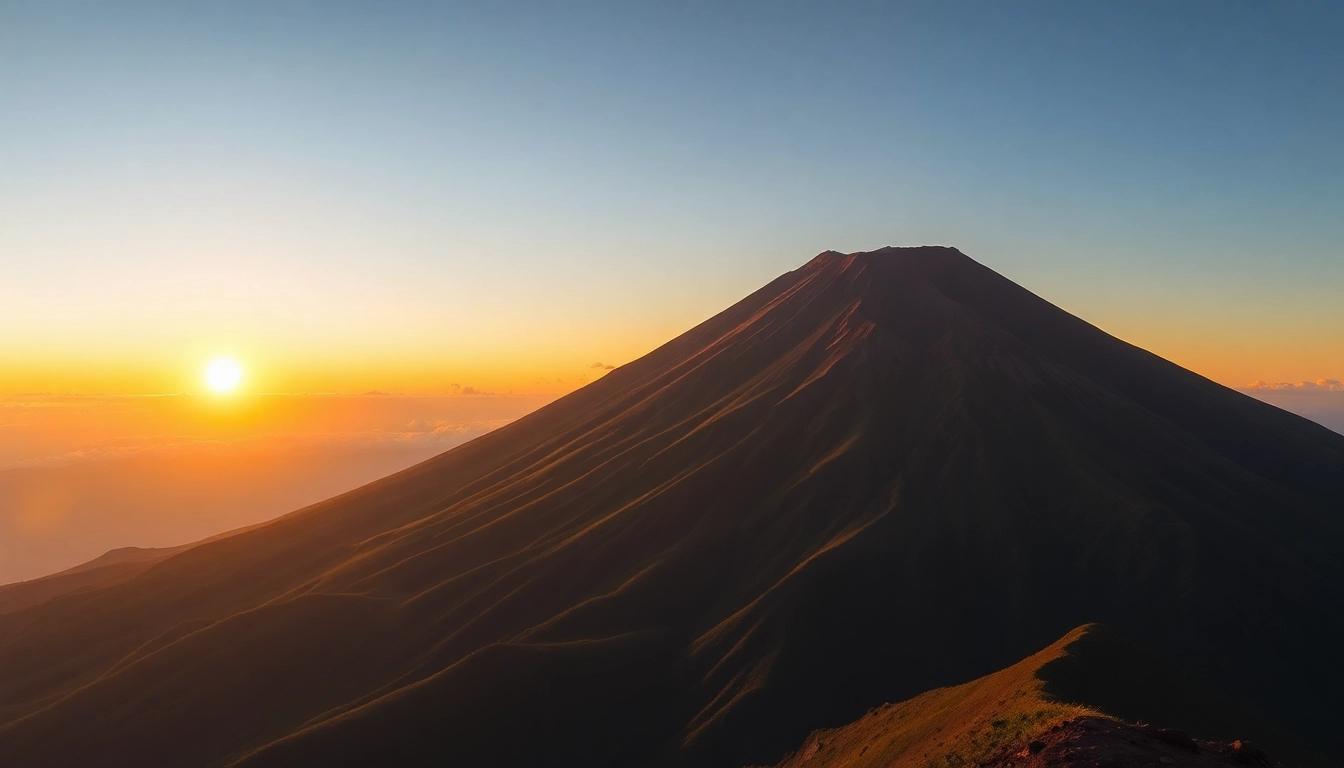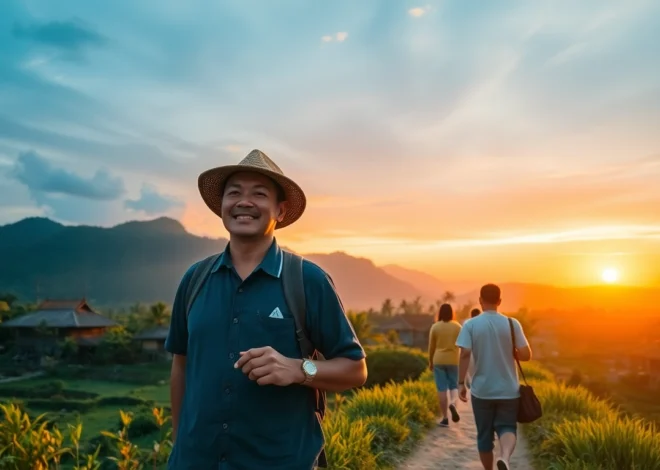
Mount Rinjani: A Comprehensive Guide to Indonesia’s Highest Volcano and Its Natural Wonders
Introduction to Mount Rinjani: Indonesia’s Second Highest Volcano
Nestled on the island of Lombok in Indonesia, Mount Rinjani stands as a breathtaking testament to the island’s volcanic activity and natural beauty. Soaring to an impressive 3,726 meters (12,224 feet), it is the second-highest volcano in Indonesia, only surpassed by Mount Kerinci. As a prominent feature of the Rinjani massif and part of the Rinjani National Park, this active stratovolcano attracts thousands of adventurers, nature lovers, and cultural enthusiasts each year.
Recognized not only for its towering presence but also for its complex geological structure and cultural significance, Mount Rinjani is a symbol of Lombok’s natural heritage and spiritual landscape. Its volcanic activity has shaped not just the terrain but also local traditions, beliefs, and ecological systems. Whether you are a seasoned trekker or a curious traveler eager to explore Indonesia’s volcanic wonder, understanding the depth of Mt. Rinjani’s geological and cultural context is essential for an enriching experience. To learn more about this remarkable mountain, visit Mt. Rinjani for comprehensive travel insights and updates.
Historical Significance and Cultural Importance
Historical Background of Mount Rinjani
Mount Rinjani holds a storied history that dates back thousands of years. Fossilized volcanic eruptions and geological analyses suggest that the site has been active for at least several hundred thousand years. Its eruptions have played a crucial role in shaping the island’s landscape and influencing the local environment. Archaeological findings also reveal that indigenous Sasak and Lombok communities have revered the mountain for centuries, integrating it into their spiritual and cultural practices.
Throughout history, the mountain has experienced several notable eruptions, with the most recent significant activity recorded in December 2015. This eruption included ash plumes rising up to 6 km, demonstrating the volcano’s ongoing geodynamic processes. Such activity underscores the importance of continuous monitoring and respect for safety protocols for visitors and nearby residents.
Cultural Significance and Local Beliefs
More than just a natural marvel, Mount Rinjani is deeply embedded in the spiritual consciousness of local communities. The mountain is considered sacred and is associated with various legends and rituals. It is believed to be the home of powerful spirits, and several traditional ceremonies are held to honor the mountain, seek blessings, or ensure safe journeys for climbers.
The Segara Anak Caldera, a prominent crater lake within the Rinjani massif, is often regarded as a spiritual site offering purification and renewal. Pilgrimages, offerings, and purification rituals are common, reflecting the intertwined relationship between natural phenomena and cultural identity on Lombok.
Geological Features and Volcanic Activity
Volcanic Structure and Formation
Mount Rinjani is classified as a stratovolcano, characterized by its layered structure built from successive eruptions of lava, ash, and volcanic debris. Its caldera, known as Segara Anak, measures approximately 7 x 10 km and contains a stunning crater lake that is a focal point for visitors. The volcano’s geology indicates a complex magma system with frequent eruptions, some of which have significantly altered the landscape.
The volcano’s main cone, Gunung Rinjani itself, stands tall as the dominant feature within the national park. Its multiple vents and underground magma channels underpin a dynamic volcanic system that remains active today, with recorded eruptions contributing to the mountain’s ever-changing terrain.
Recent Volcanic Activity and Monitoring
Scientists continually monitor Rinjani’s activity owing to its status as an active volcano. The Indonesian Center for Volcanology and Geological Hazard Mitigation (PVMBG) keeps a close watch on seismic activity, gas emissions, and ground deformation signals. The 2015 eruption, which lasted two months, caused widespread ash and lava flows, impacting nearby communities and necessitating temporary evacuations.
Modern techniques such as remote sensing, seismic networks, and gas analyzers enable early warning systems to inform both authorities and tourists. Travelers are advised to stay informed about current activity levels and adhere to safety instructions issued by local authorities and park management.
Location and Accessibility in Lombok
Geographical Setting
Mount Rinjani is situated within the north-central part of Lombok island, in the West Nusa Tenggara province. It spans the administrative regions of North Lombok and Central Lombok, providing a natural boundary that defines the island’s diverse terrains. The region features lush rainforests, terraced rice paddies, and pristine beaches that complement the grandeur of the volcano.
Getting There and Infrastructure
Accessibility to Rinjani is well-established, with the main entrance points located in the towns of Sembalun and Senaru. These gateways offer different trekking routes and vary in terrain difficulty, providing options for various levels of hikers. Visitors typically get to Lombok via Lombok International Airport in Praya, which is well-connected to major Indonesian hubs such as Jakarta and Bali.
From the airport, travelers travel by car or public transportation to the base camps. Once on the trail, guided trekking tours often include transportation, permits, and logistics management, making the journey more accessible even for less experienced hikers.
Planning Your Trekking Adventure on Mount Rinjani
Best Time to Visit and Weather Conditions
The optimal period to undertake the Mount Rinjani trek is during the dry season, which typically spans from April to October. During these months, the weather is most favorable, with clear skies, lower humidity, and minimal rainfall—factors that significantly improve safety and enjoyment.
Just before and after this period, weather can be unpredictable, with increased risks of rain and fog, which may hinder visibility and trail safety. It’s important to check current meteorological forecasts and park advisories before planning your expedition, as volcanic activity can also influence access and safety.
Required Equipment and Preparation Tips
Preparing adequately ensures a safe and enjoyable trek. Essential gear includes sturdy hiking boots, layered clothing (thermal wear, waterproof jackets, windbreakers), a sleeping bag, and tent if camping overnight. Other必 fo necessary items contain headlamps, trekking poles, high-energy snacks, water purification devices, and first aid kits.
Altitude acclimatization, physical conditioning, and mental readiness are crucial for such a demanding trek. Engaging in regular cardio exercises, hiking practice, and learning about altitude sickness symptoms can make a significant difference.
Choosing Guided Tours and Permits
Due to the challenging terrain and strict conservation regulations, hiring a certified guide is highly recommended. Guides assist with navigation, safety protocols, and cultural insights, enhancing the overall experience. Guided tours also arrange necessary permits, meals, and accommodation, simplifying the logistics of your expedition.
Permits are mandatory for entry into Rinjani National Park and can be obtained via authorized tour operators or park offices. Early booking is advisable, especially during peak season, to secure your spot and ensure comprehensive planning.
Hiking Routes and Experience Levels
Popular Trekking Trails: Sembalun and Senaru
The two primary routes to summit Mount Rinjani are the Sembalun and Senaru trails, each offering unique landscapes and challenges:
- Sembalun Route: Known for its relatively gentle ascent, this trail begins from the Sembalun Lawang village. It traverses volcanic plains, lush savannahs, and offers spectacular sunrise vistas. Suitable for trekkers seeking a less technical challenge with a panoramic perspective of the volcano.
- Senaru Route: Starting from the village of Senaru, this trail is more challenging, with steeper inclines and richer rainforests. It provides a more immersive jungle experience and passes through diverse ecosystems, ending at the crater rim.
Both routes converge and lead toward the crater rim, where climbers can witness features like the hot springs and Caldera Lake.
Trail Difficulty and Duration per Route
The Sembalun route typically takes 2-3 days for ascent and descent, depending on trekking pace and acclimatization. It covers approximately 27 km with moderate difficulty. The Senaru route, being more demanding, often spans 3-4 days, offering a profound connection with the jungle environment and volcanic landscapes.
Preparation for these routes involves physical fitness, prior hiking experience, and understanding of the terrain. Challenging sections may include volcanic scree, steep inclines, and high-altitude exposure.
Highlights and Key Landmarks along the Trek
Trekkers encounter several highlights, such as:
- Segara Anak Crater Lake: An awe-inspiring crater lake with vibrant blue waters, regarded as the heart of the volcano.
- Hot Springs of Rinjani: Natural thermal springs near the crater offer relaxation and therapeutic benefits.
- Summit at Puncak Rinjani: The peak provides panoramic views of the surrounding islands, including Bali and Sumbawa on clear days.
- Emerald and Green Terraces: The lush landscapes and terraced fields along the routes highlight Lombok’s agricultural beauty.
Wildlife, Flora, and Natural Attractions of Rinjani National Park
Unique Ecosystems and Biodiversity
Rinjani National Park spans approximately 41,330 hectares, encapsulating diverse ecosystems ranging from tropical rainforests to alpine grasslands. It is a haven for endemic and migratory species, offering a remarkable biodiversity:
- Endemic bird species such as the Rinjani scops owl and the Flores monarch.
- Reptiles including geckos and monitor lizards adapted to volcanic terrains.
- Rich flora comprising orchids, ferns, and montane forests that thrive at different elevations.
Scenic Waterfalls and Hot Springs
The park features numerous waterfalls that cascade through lush valleys, ideal for photography and relaxation. Notable among them are the Tiu Kelep and Sendang Gile waterfalls, located near Senaru. The thermal hot springs near Segara Anak provide soothing baths amid volcanic scenery, known for their healing properties.
Summiting and Sightseeing Tips
For spectacular sightseeing, plan to catch sunrise at the crater rim, which offers a striking view of the caldera and surrounding islands. Early mornings and clear weather significantly enhance visual experiences. Carry binoculars, camera gear, and layered clothing to adapt to changing weather conditions.
Safety, Challenges, and Conservation Efforts
Common Trekking Challenges and How to Prepare
Hiking Mount Rinjani presents various challenges:
- Altitude Sickness: Symptoms include headaches, dizziness, and fatigue. Acclimatization, hydration, and pacing are essential preventive measures.
- Volcanic and Weather Risks: Sudden eruptions or ash plumes require vigilant monitoring. Prepare for rapid weather changes with appropriate gear.
- Physical Demands: The trek demands endurance; regular training, strength conditioning, and mental resilience are key to completing the journey.
Guides and local experts emphasize safety protocols, including respecting park restrictions, following designated trails, and listening to volcanic alerts.
Volcanic Eruptions and Safety Precautions
Due to its active status, predictable eruptions pose risks. Visitors should consult official alerts and heed evacuation instructions. The Indonesian authorities implement warning systems such as seismic sensors and gas emission monitors to safeguard tourists and locals.
It is recommended to avoid hiking during heightened activity and to carry personal safety items like masks, flashlights, and communication devices during the climb.
Preserving the Rinjani Environment for Future Visitors
Sustainable tourism practices are vital for conserving Rinjani’s natural beauty. Visitors are encouraged to practice Leave No Trace principles, minimize waste, and support local conservation initiatives.
Park management enforces strict regulations on camping, littering, and guide licensing to ensure that ecological impacts are kept in check. Educating hikers about endemic species and fragile ecosystems fosters a sense of shared responsibility for preservation.
